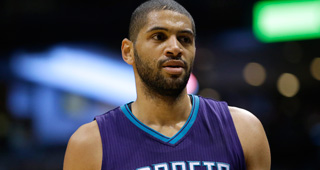The Charlotte Hornets are coming off one of the more successful seasons in franchise history, and certainly the best for this current iteration of the club. Their 48 wins were a 15-game improvement over the previous year and their offense far outpaced last season by improving from 28th in the league to 9th. With younger pieces like Kemba Walker, Michael Kidd-Gilchrist and Jeremy Lamb signed long-term and one of the best coaches in the league, Steve Clifford, the general state of the Hornets produces optimism.
The Hornets' offensive improvement was aided by the addition of Nicolas Batum via a draft night trade in 2015 with the Blazers. Although he’s not a pure scorer, Batum’s all-around play helped Charlotte substantially, especially by allowing Walker to play off the ball more often. Walker had his best offensive season and lifting the burden of handling the ball all the time certainly helped. Charlotte also boasts a slew of good screeners, which allowed him to get open for easy looks on a regular basis with deliveries coming from Batum.
Another big part of the Charlotte improvement was extremely efficient offensive seasons from Marvin Williams and Cody Zeller. Both players were average on defense, but far out performed that on the scoring end. Williams started all season, which was unexpected by many, and he delivered excellent inside/outside play. Zeller ended up starting the majority of games due to Al Jefferson’s continued injury issues and he had the best season of his career.
The trade deadline acquisition of Courtney Lee gave the Hornets a consistent offensive performer at SG, when they had been previously getting by with P.J. Hairston at that spot. Lee added outside shooting, good defense, and another ball handler to the lineup. He’s a free agent and a player the Hornets want back if the bidding doesn’t get out of control.
An anomaly of sorts that helped the offense was the addition by subtraction of Jefferson and Kidd-Gilchrist. Jefferson, once the proclaimed “Lord of the Left Block”, has slipped in recent years. For a long time, a one-on-one coverage of Jefferson in the post generally resulted in an automatic basket. As injuries have sapped his already limited athleticism and quickness, he’s no longer a lock to score inside. Despite this, the Hornets continued to play through him on a regular basis, which slowed the pace of the game and removed shots from more efficient options. Once Jefferson went down and Zeller was inserted, the pace picked up, the offense became more perimeter-oriented and the ball movement was far better. When Jefferson returned, he came off the bench and that may be his role in the NBA going forward. He can still score against overmatched backup centers and the lack of pace isn’t as much of a concern with a second unit for shorter minutes.
Kidd-Gilchrist, for all his terrific defensive abilities and his improvement on offense, remains a liability on that end. He needs to be surrounded by players who can help cover his lack of range and ideally performs best in a system that pushes pace. Williams having a career year shooting wise made Kidd-Gilchrist expendable for at least this year. If the Hornets are committed to playing faster going forward, which should result in more transition and early clock opportunities for Kidd-Gilchrist, the team may be set on the wing. Kidd-Gilchrist's ability to also play some small ball PF only helps his value in a league that is going small more often.
This brings us to what should be a very interesting offseason for Charlotte. As noted above, the Hornets have their starter at PG (Walker) and at one wing position (MKG) and presumably at center or power forward (Zeller). Additionally, a backup big spot is filled by last year’s first round pick, Frank Kaminsky, after an up and down rookie year. He competed better than was expected on defense, but was often tentative with the ball on offense. With another year of experience he should be a dependable backup option at PF/C. Another backup spot is held down by Lamb. After years of never quite getting there with Oklahoma City, Lamb was a consistent reserve for the Hornets. He played the best defense of his career and his offensive numbers were better, as he focused more on getting to the basket vs being stuck in the corner waiting for jumpers like he was in OKC.
With five spots spoken for, the Hornets need to decide which of their free agents they want to re-sign, or if it is time to go in another direction. As previously said, Lee is wanted back. The Hornets envision him as either a starting wing or a high level reserve. Where Lee could play will be influenced by the biggest decision of the summer: whether or not Batum returns. Word is that Batum wants to return, and that is welcomed news for Charlotte. He was very good last year as a primary option for the first time in his career, and he’s only 28 years old next season. Pairing Batum and Lee with the other players back in Charlotte should give the Hornets enough ammo to continue to compete in the postseason.
Of course, just making the playoffs isn’t the ultimate goal. The Hornets' other free agents could go a long way in making the desired improvement a reality. The team would like to have both Marvin Williams and Jeremy Lin back as well. For Williams, the team would like him back in a reduced role where he can be a backup. This should keep Williams fresh and productive, while also allowing for minutes for the younger player. His veteran influence and production on the court could have him looking to cash in on one last big contract however, and the Hornets will only go so far to bring him back.
Lin was productive both backing up Walker and playing beside him. He’s almost guaranteed to opt out and look to take advantage of a weak starting caliber PG market. If more money and a starting role are offered elsewhere, Lin’s time in Charlotte is probably limited to one season. Despite the production he gave them, the Hornets can probably replace him with a more efficient backup PG who is a better defender and better without the ball in his hands. Players like Matthew Dellavedova, Isaiah Canaan, and Tyler Johnson come to mind in that role.
The final big free agent decision is whether or not the Hornets should move on from Al Jefferson, the player who helped initiate the turnaround as Michael Jordan’s first big signing. He’s an unrestricted free agent and could still command a salary north of $10 million per season as a scoring big off the bench. With Zeller, Kaminsky and Spencer Hawes, all still in the fold, it might be time for Jefferson to take up residence on the left block somewhere else.
The Hornets made big strides this year by committing to a different style of play and the growth of the younger players. Their ability to continue that forward momentum is tied to retaining their own free agents this summer. Unfortunately, until Batum, Lee, Williams, Lin and Jefferson make decisions, or are decided upon by the team, the Hornets won’t have the cap space to do much else. And if the key players of Batum, Lee and Williams return, the team is unlikely to have the cap space to do much else.
The Hornets are in a tricky situation. They are a good team, but not yet a contender. Their ability to add pieces to become a contender is somewhat limited, since they are largely looking at bringing back their own free agents. It is important that they avoid unnecessary large or, just as critical, long deals. Charlotte has been smart so far by signing Walker, Kidd-Gilchrist and Lamb to under market value contracts. Continuing on a similar path and avoiding bad deals should set the team up for sustained success moving forward.
Offseason Details
Guaranteed Contracts (6): Spencer Hawes, Frank Kaminsky, Michael Kidd-Gilchrist, Jeremy Lamb, Kemba Walker, Cody Zeller
Partial/Non-Guaranteed Contracts (1): Aaron Harrison
Potential Free Agents (8): Nicolas Batum (UFA), Troy Daniels (RFA), Jorge Gutierrez (RFA), Tyler Hansbrough (UFA), Al Jefferson (UFA), Courtney Lee (UFA), Jeremy Lin (UFA – Player Option), Marvin Williams (UFA)
“Dead” Money on Cap (0): None
First Round Draft Picks: # 22
Maximum Cap Space: $42,830,474
Projected Cap Space: Non. $20,566,624 over



